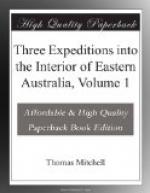RIDE TO THE DARLING.
I then gave them a piece of my broken sword, and set off with a party on horseback to see the river Darling. By half-past ten I made this river at a distance of eight miles from our camp, by riding first three miles west, and then five in the direction of 20 degrees north of west by compass. The people with me immediately declared it was our old acquaintance the Karaula, unaltered in a single feature. Here we saw the same description of broken earthy banks; the same kind of lofty trees, and the long, deep, and still reaches, so characteristic of a lengthened and slumbering course.
THE WATER SWEET.
But the great question to be determined was the quality of the water, which, appearing to me from the top of the bank, very transparent, and of a greenish tinge, and without any indication of a current, I did not doubt was salt, as when first discovered in nearly the same latitude by Sturt. I was however so agreeably surprised, on descending the steep bank, to find the taste perfectly sweet, that I began to doubt if this river could be The Darling, thinking, from the difference in the longitude especially, that it might still be the lower part of the Bogan, the course of which continued westward, and on my right as I rode from the camp. I proceeded some distance down the river, and found the reaches to extend first west-north-west, next north-north-east (half a mile) then south-west by south (1 1/2 miles); I was at length satisfied that this was indeed the river Darling, and I was no less gratified in perceiving a slight current in it with no obstruction for our boats as far as I had yet examined. The paths of the natives were fresh-trodden, but we saw none of them, and I returned towards the camp, where I arrived by two P.M. The bed of the Darling at the place where we reached it could not be elevated more, according to the state of the barometrical column (as compared at the time with that of my barometer as it had stood at Parramatta bridge) than 250 feet above the level of the sea.
NATIVES AFRAID OF THE SHEEP.
I found that the natives whom I had left at the camp no longer remained there, having quitted it soon after my departure, apparently afraid of the sheep!
May 26.
A party of our friends the natives again made their appearance; and five of them, including the three who had visited us yesterday, took their stations under the same tree, while a number of gins and children remained on the border of the scrub, half a mile off. Just before the camp broke up I went to them and gave a tomahawk to an old grey-haired man. The chief spokesman was a ferocious forward sort of savage, to whom I would rather have given anything than a tomahawk, from the manner in which he handled my pockets. My horse awaited me and I by signs explained to them that I was going. I suspect that Watta is their familiar name for the Darling from their use of this word on any sign being made in reference to the river.




